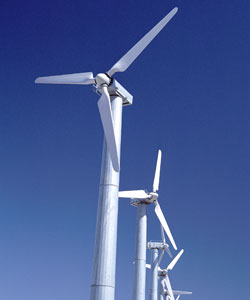
April 20, 2011 – In March 2011, the Wisconsin Legislature’s Joint Committee for the Review of Administrative Rules, in an unusual step, suspended proposed Public Service Commission (PSC) rules for the uniform local regulation of wind power. This article summarizes the provisions of 2009 Wisconsin Act 40 limiting local control over wind energy systems, discusses the provisions of the draft PSC rules, and sketches out the current state/local scheme for the regulation of wind energy systems in Wisconsin.
A wind energy system is defined as “equipment and associated facilities that convert and then store or transfer energy from the wind into usable forms of energy.”1 Historically, the regulation of wind energy systems had been entirely a matter of local concern. In 1994, however, the Legislature limited the power of local governments to regulate wind energy systems by prohibiting any restriction that did not:
- preserve or protect the public health or safety;
- significantly increase the cost of the system or significantly decrease its efficiency; or
- allow for an alternative system of comparable cost and efficiency.
While one would reasonably have assumed that local governments could regulate wind energy systems by ordinance, the court of appeals in Eckers Brothers v. Calument County held that Calumet County’s wind energy ordinance was ultra vires and that “political subdivisions must rely on the facts of an individual situation to make case-by-case restrictions.”2 The court decided that the Legislature had already made the policy decision to favor wind energy and, therefore, that political subdivisions could only “assist” in effectuating that policy, through the issuance of conditional use permits.
Local control over wind energy systems was further limited by 2009 Wisconsin Act 40. Effectively reversing Ecker Brothers,3 Act 40 requires that any political subdivision desiring to regulate wind energy systems must do so by ordinance.4 Act 40 also standardizes municipal procedures, provides for PSC review of local determinations, and requires that municipal regulations be no more restrictive than rules promulgated by the PSC. The PSC attempted to promulgate those rules late in 2010, but that effort was halted in March 2011, when the Legislature’s Joint Committee for the Review of Administrative Rules suspended proposed Wis. Admin. Code ch. PSC 128.5
2009 Wisconsin Act 40

Municipal procedures. Act 40 requires that any political subdivision desiring to regulate wind energy systems must do so by ordinance. The Act also limits the scope of such ordinances. It sets deadlines for action on permit applications, and requires a formal record of proceedings and written findings of fact supported by substantial evidence.6 Unsuccessful applicants may appeal local decisions to the PSC.7
PSC rules. Act 40 provides that the PSC rules shall:
- Specify the restrictions local governments may impose, and establish “setback requirements that provide reasonable protection from any health effects, including health effects from noise and shadow flicker associated with wind energy systems;”8 and
- Specify the contents of local permit applications, procedural requirements, enforcement mechanisms9; and
- For larger systems, require proof of financial responsibility for decommissioning.10
Wind Siting Council. Act 40 created a new agency, the Wind Siting Council to:
- Survey the peer-reviewed scientific research regarding the health impacts of wind energy systems;
- Study state and national regulatory developments regarding the siting of wind energy systems;
- Report to the Legislature every five years11; and
- Advise the PSC on the contents of its rules (except regarding financial responsibility for decommissioning).12
Miscellaneous provisions
Act 40 requires the Department of Natural Resources to identify where the placement of wind turbines may have “a significant adverse effect on bat and migratory bird populations.”13 A political subdivision may not restrict testing potential sites but allows local governments to petition the PSC to restrict proposed testing activities.14 The standards for local regulation of wind energy systems do not apply to an application to the PSC to construct a “large electric generating facility” (that is, a facility of 100 megawatts or more), but the PSC must consider those standards in deciding whether to issue a certificate of public convenience and necessity for such facilities.15
Draft Wis. Admin. Code ch. PSC 128
In August 2010, the Wind Siting Council released its recommendations regarding the rules called for by Act 40.16 One month later, the PSC issued its proposed rules.17 The key substantive provisions of the draft rules included the following:
- sets turbine setback distances from residences at 3.1 times the maximum blade tip height;
- sets noise limits at 50 dBA during the day and 45 dBA at night;
- limits shadow flicker to 30 hours per year; and
- permits “good neighbor” payments to owners of adjacent properties.
Late in October 2010, the Senate’s Committee on Commerce, Utilities, Energy and Rail sent the draft rules back to the PSC for modifications. The PSC modified the setback requirement to the lesser of 1,200 feet or 3.1 times the maximum blade tip height, and reduced the maximum allowable payment to “good neighbors.”18 In March 2011, the Joint Committee for the Review of Administrative Rules suspended the draft rules on the ground that they “create an emergency relating to public health, safety, or welfare; are arbitrary and capricious; and impose an undue hardship on landowners and residents adjacent to wind turbine sites....”19
Conclusion
As the law now stands, there is no regulation of wind energy systems in any political subdivision of the state that has not adopted an ordinance. Under Act 40 the PSC is still required to promulgate rules setting standards for such ordinances. Until the PSC acts (or Act 40 is modified) local governments are free to adopt their own requirements, consistent with the general standards in Wis. Stat. section 66.0401(1m).
About the author
Edward S. Marion, U.W. 1974, now in private practice, was the general counsel and administrative law judge at the Public Service Commission of Wisconsin from 1998 through 2008. He is the current chair of the State Bar’s Energy and Telecommunications Law Section.
Endnotes
